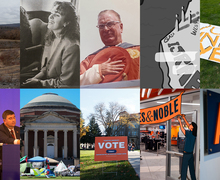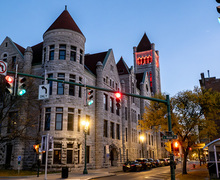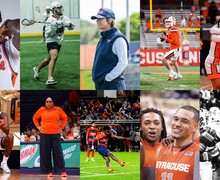SU adapts to rise in number of student veterans
For as long as she could remember, Ginger Gunnip needed a break.
Her mother struggled with psychological issues and a back problem. Her father popped in and out of her life, usually too busy dealing with his drug addiction to support his family.
So Gunnip did the job for him. She supported her mother and older sister. Worked at an airport to make money. Left home after refusing to move to Wisconsin. Found a job at a research lab during a high school recruitment assembly. Got a herniated disk in her back at 19 and was fired before it completely healed.
By the time she turned 23, she was ready for a break. So she joined the Army and was deployed to Iraq a few months later.
‘It’s funny when that’s break for you,’ Gunnip said.
Now the 27-year-old sophomore biomedical engineering major is one of 177 student veterans at Syracuse University, a population of students that has increased by 31 percent since last year.
SU has continuously been a place for veterans. When the first class of veterans graduated with the G.I. Bill in 1950, the group was one of the largest classes in university history. But as times have changed, so has how the university chooses to serve its student veteran population.
The recent growth in the number of student veterans since the Post-9/11 G.I. Bill, enacted in August 2009, prompted the university to improve outreach initiatives for veterans. From establishing a new veterans center to creating writing and business programs, SU began to offer ways that made for an easier transition from military life to civilian life.
For Gunnip, returning to civilian life meant leaving the war in Iraq for an education in Syracuse. It meant a chance to start a new family with her husband and their baby. It meant an opportunity to release some of the stress she experienced in the Army.
And she did it through the only way she knew how: writing. She did it with the help of a group created to offer student veterans a creative outlet to express their emotions.
Eileen Schell, chair of the writing program, founded the Syracuse Veterans’ Writing Group in March 2010 and opened it up to veterans around the Syracuse area. One Saturday a month, typically from 10 a.m. to noon, about half a dozen veterans gather at the writing center. They spend the morning writing about their military experiences, sharing their work and receiving feedback.
But the meetings are more than just a chance to participate in a writing workshop, Schell said. They are a place for veterans to reflect publicly about their military life, without the fear of being judged. Veterans of different generations — from those who had been in Vietnam to those who just came back from Iraq — come together, share and listen.
‘I don’t see it as therapy, but I think stories can have healing effects,’ said Schell, co-director of the Syracuse Veterans’ Writing Group. ‘It’s a space to support the kind of reflection and analysis and storytelling that many veterans like to undertake.’
A few years before the writing group was created, a veteran-specific business program — called the Entrepreneurship Bootcamp for Veterans with Disabilities — was established at SU in 2007.
The Martin J. Whitman School of Management recognized the need to accommodate post-9/11 student veterans and offered entrepreneurship training to those with psychological or physical disabilities, said Raymond Toenniessen, director of the veteran outreach programs.
The number of student veterans who applied for the program, which caps its class at 25 veterans, began to increase over the years, Toenniessen said. So did the type of disabilities. There were some amputees. Many suffered from post-traumatic stress disorder. Others had vision problems. Some were as young as 19, others as old as 55.
The program serves as an ‘intervention’ for the student veterans, Toenniessen said, and it helps them heal.
The 2007 pilot class had 20 student veterans, Toenniessen said. Seventeen of them now have a business that serves as their only source of income. Five posted revenues of more than $1 million. One posted revenues of more than $4 million. Two posted revenues of more than $15 million for a joint venture.
‘It’s given them something they really want to go for, really want to succeed,’ Toenniessen said.
But veteran-specific programs on the SU campus only recently came into existence.
Christopher Collins served in the Marine Corps immediately after graduating high school. He went to Iraq twice, from 2003 to 2006, and served in the infantry. By the time he enrolled at SU, he was 22 years old.
‘It was hard the first year, I’m not going to lie,’ said Collins, a senior information management and technology major. ‘It took me a while to get adjusted to the college lifestyle.’
Things he had been taught in the Marine Corps — especially about vigilance — carried over into his campus life. Collins didn’t like the bigger classes. He wasn’t too fond of people sitting behind him, either. And sometimes he was cautious of his surroundings when he walked around campus.
Then there were the people. Most of the students were grateful and thanked him for his service, he said. But some were immature. Others lacked discipline. A few just wanted to know how many people he killed in the war.
‘They don’t understand — I don’t really fully expect them to because they haven’t been there, and it’s just a really tough concept to grasp,’ he said.
SU claimed to be a veteran-friendly campus, Collins said, but the university did not cater to student veterans’ needs during his first two years. He wanted to exchange war stories. He wanted to share his experiences without being asked to explain the military lingo. He wanted to bond with other veterans, even if they had been in a different branch. He needed a ‘getaway.’
It was a sentiment shared by many student veterans. SU alumnus Brian Lance, who transferred to SU as a magazine journalism major, wanted that getaway, too.
The 2010 graduate served in the Navy from 1999 to 2004 and was stationed in Asago, Japan. Lance went from regular high school student to Navy veteran to 26-year-old junior in college — an experience shared by few others.
‘Being a student after being in the military is a lot different than being a student the first time around,’ he said. ‘I was a lot older, and I didn’t have the same common experiences as everybody else.’
That five-year age difference was the biggest obstacle. Interaction with undergraduate students was limited. So was his involvement in campus organizations, except when he served briefly as the opinion editor of The Daily Orange.
‘For me, I felt kind of distant,’ he said.
That was until the SU chapter of the Student Veterans of America was established in 2009. The same year, the SU Veterans Resource Center opened at University College.
‘If anything, it gave us a place to hang out and swap stories,’ Lance said.
For Lance and many others, having that place was important. Student veterans became more visible on campus. They found people who were closer to their age.
The Veterans Resource Center, which provides a lounge for student veterans to gather or use as a quiet place to study, is a site on campus for them to call home, said Keith Doss, a veterans adviser.
The center helps them with their paperwork, sometimes with the certification process with the Department of Veteran Affairs and other things with referrals from local organizations. It also helps student veterans with on-campus problems, such as with the housing office, and raises awareness for veteran-specific on-campus organizations.
Student veterans’ presence on the SU campus is valued, Doss said.
‘They’ve all made contributions to our country and served our country,’ he said. ‘Bringing that onto campus shows a very large dedication to not only what they’ve done, but to the different experiences they can offer to the SU campus.’
Published on March 27, 2011 at 12:00 pm





